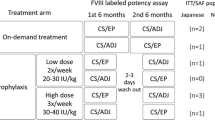Abstract
A multicenter and open-labeled clinical trial of human recombinant factor VIIa (rFVIIa) was conducted in Japanese patients with severe hemophilia A or B with inhibitors. The trial consisted of 2 parts. In study 1, the pharmacokinetics, pharmacodynamics, and safety of a single dose of 120 μg/kg ofrFVIIa were investigated in 8 patients. In the subsequent study 2, the hemostatic effect and safety ofrFVIIa were evaluated during a 24-week period in 10 patients. In study 1, the mean maximum FVII-coagulant activity (FVII:C) was found to occur after 10 minutes; activity then decreased rapidly and returned to the baseline within 24 hours after a single intravenous infusion of rFVIIa. The mean half-life of FVII:C was 3.5 hours. The activated partial thromboplastin time and prothrombin time in the patients were immediately shortened but returned to the baseline within 24 hours after dosing. In study 2, 86 μg/kg to 120 μg/kg ofrFVIIa (mean, 97 μg/kg) was administered 1 to 85 times to 10 patients. A total of 58.0% (91/157) of bleeding episodes were treated excellently or effectively, with 5 (3.2%) ineffective episodes. There was no apparent trend in the relationship of the hemostatic effect with bleeding sites, mean dose, or number of injections. The efficacy rate, however, was significantly higher (90.0%) in bleeding episodes treated within 3 hours than in those treated at longer intervals (31.0%). No treatment-related adverse events were observed, and there was no evidence of antibody formation to rFVIIa. In conclusion,rFVIIa is an effective and well-tolerated option for treatment of bleeding episodes in hemophilia patients with inhibitors.
Similar content being viewed by others
References
Scharrer I, Bray GL, Neutzling O. Incidence of inhibitors in haemophilia A patients: a review of recent studies of recombinant and plasma-derived factor VIII concentrates.Haemophilia. 1999;5:145–154.
Aledort LM. Inhibitors in hemophilia patients: current status and management.Am J Hematol. 1994;47:208–217.
Macik BG. Treatment of factor VIII inhibitors: products and strategies.Semin Thromb Haemost. 1993;19:13–24.
Negrier C, Goudemand J, Sultan Y, et al, and the members of the French FEIBA study group. Multicenter retrospective study on the utilization of REIBA in France in patients with factor VIII and factor IX inhibitors.Thromb Haemost. 1997;77:1113–1119.
Fukui H, Fujimura Y, Takahashi Y, Mikami S, Yoshioka A. Laboratory evidence of DIC under FEIBE treatment of haemophilic patient with intracranial bleeding and high titer factor VIII inhibitor.Thromb Res. 1981;22:177–184.
Cederbaum AI, Blatt PM, Robert HR. Intervascular coagulation with use of human prothrombin complex concentrates.Ann Intern Med. 1976;84:683–687.
Fuerth JH, Mahrer P. Myocardial infraction after factor IX therapy.JAMA. 1981;245:1455–1456.
Hagen FS, Gray CL, O’Hara P, et al. Characterization of acDNA coding from human factor VII.Proc Natl Acad Sci U S A. 1986;83:2412–2416.
Bjoern S, Thim L. Activation of coagulation factor VII to VIIa.Res Disclosure. 1986;269:564–565.
Thim L, Bjoern S, Christensen M, et al. Amino acid sequence and posttranslational modifications of human factor VIIa from plasma and transfected baby hamster kidney cells.Biochemistry. 1988;27:7785–7793.
Hedner U. Factor VIIa in the treatment of hemophilia.Blood Coagul Fibrinolysis. 1990;1:307–317.
Hedner U, Glazer S, Falch J. Recombinant activated factor VII in the treatment of bleeding episodes in patients with inherited and acquired bleeding disorders.Transfusion Med Rev. 1993;7:78–83.
Ingerslev J, Freidman D, Gastineau D, et al. Major surgery in haemophiliac patients using recombinant Factor VIIa.Haemostasis. 1996;26(suppl 1):118–123.
Shapiro AD, Glichrist GS, Hoots WK, Cooper HA, Gastineau DA. Prospective, randomised trial of two doses of rFVIIa (NovoSeven) in haemophilia patients with inhibitors undergoing surgery.Thromb Haemost. 1998;80:773–778.
Key NS, Aledort LM, Beardsley D, et al. Home treatment of mild to moderate bleeding episodes using recombinant factor VIIa (NovoSeven) in haemophiliacs with inhibitors.Thromb Haemost. 1998;80:912–918.
Lusher JM, Roberts HR, Davignon G, et al. A randomized, double-blind comparison of two dosage levels of recombinant factor VIIa in the treatment of joint, muscle and mucocutaneous haemorrhages in persons with haemophilia A and B, with and without inhibitors.Haemophilia. 1998;4:790–798.
Macik BG, Lindley CM, Lusher J, et al. Safety and initial clinical efficacy of three dose levels of recombinant activated factor VII (rFVIIa): results of a Phase I study.Blood Coagul Fibrinolysis. 1993;4:521–527.
Lusher J, Ingerslev H, Roberts H, Hedner U. Clinical experience with recombinant factor VIIa.Blood Coagul Fibrinolysis. 1998;9:119–128.
Novo Nordisk. NN-007 Phase I/II clinical trial (Study 1): study of the safety, pharmacokinetics and pharmacological effect of NN-007 in hemophiliac patients with inhibitors after single administration (Trial ID:F7/HAEM/J/1/J): pharmacokinetics [internal document]. 1999.
Komiyama Y, Pedersen AH, Kisiel W. Proteolytic activation of human factors IX and X by recombinant human factor VIIa: effects of calcium, phospholipids, and tissue factor.Biochemistry. 1990;29:9418–9425.
Novo Nordisk: Clinical study report of the trial F7HAEM/USA/2/USA [internal document]. February 14, 2000.
Saito H, Takamatsu J, Kamiya T, et al. Clinical study of recombinant factor VIIa (NN-007) in hemophilia patients with inhibitors.Jpn J Thromb Hemost. 1994;5:158–172.
Lindley CM, Sawyer WT, Macik BG, et al. Pharmacokinetics and pharmacodynamics of recombinant factor VIIa.Clin Pharmacol Ther. 1994;55:638–648.
Author information
Authors and Affiliations
About this article
Cite this article
Shirahata, A., Kamiya, T., Takamatsu, J. et al. Clinical Trial to Investigate the Pharmacokinetics, Pharmacodynamics, Safety, and Efficacy of Recombinant Factor VIIa in Japanese Patients With Hemophilia With Inhibitors. Int J Hematol 73, 517–525 (2001). https://doi.org/10.1007/BF02994016
Received:
Revised:
Accepted:
Published:
Issue Date:
DOI: https://doi.org/10.1007/BF02994016



